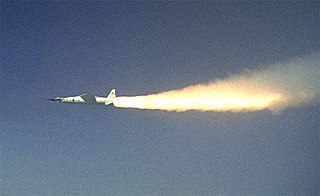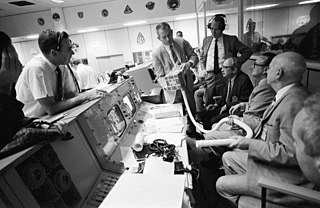
The NASA X-43 was an experimental unmanned hypersonic aircraft with multiple planned scale variations meant to test various aspects of hypersonic flight. It was part of the X-plane series and specifically of NASA's Hyper-X program. It set several airspeed records for jet aircraft. The X-43 is the fastest jet-powered aircraft on record at approximately Mach 9.6.

The American Institute of Aeronautics and Astronautics (AIAA) is a professional society for the field of aerospace engineering. The AIAA is the U.S. representative on the International Astronautical Federation and the International Council of the Aeronautical Sciences. In 2015, it had more than 30,000 members among aerospace professionals worldwide.

Robert T. Jones,, was an aerodynamicist and aeronautical engineer for NACA and later NASA. He was known at NASA as "one of the premier aeronautical engineers of the twentieth century". The papers of Robert T. Jones are in the Stanford University Libraries archives.

Gregory Errol Chamitoff is a Canadian-born American engineer and former NASA astronaut. He has been to space twice, spending 6 months aboard the ISS across Expedition 17 and 18 in 2008, and another 15 days as part of STS-134 in 2011. STS-134 was the last of Space Shuttle Endeavour which delivered the Alpha Magnetic Spectrometer and completed the US Orbital Segment.

Guy Antony Jameson, FRS, FREng is Professor in the Department of Aerospace Engineering at Texas A&M University. Jameson is known for his pioneering work in the field of computational fluid dynamics. He has published more than 300 scientific papers in a wide range of areas including computational fluid dynamics, aerodynamics, and control theory.
Jan Roskam was the Deane E. Ackers Distinguished Professor of Aerospace Engineering at the University of Kansas. He is the author of eleven books on airplane design and flight dynamics and over 160 papers on the topics of aircraft aerodynamics, performance, design and flight controls. He founded the company DARcorporation with Willem Anemaat.
Diamond Lewis (Tino) Mingori is an American who was a longtime professor of Mechanical & Aerospace Engineering at the University of California at Los Angeles (UCLA). He currently serves as a Professor Emeritus. His research and teaching focused on attitude dynamics and control, stability theory, nonlinear methods, applications to space and ground vehicles.

Mercedes Reaves is a Puerto Rican research engineer and scientist. She is responsible for the design of a viable full-scale solar sail and the development and testing of a scale model solar sail at NASA Langley Research Center in Virginia.
Edward W Ng was an American applied mathematician who had also held the positions of senior scientist, senior engineer and technical manager in the U.S. Space Program. He is noted for his broad variety of mathematical applications in space science and engineering. He has also contributed conscientiously in the spin-off of technology from the space program, with applications in such diverse subjects as Bose–Einstein distribution in mathematical physics, symbolic and algebraic computation, computational physics and biomedical research.

Aerospace engineering is the primary field of engineering concerned with the development of aircraft and spacecraft. It has two major and overlapping branches: aeronautical engineering and astronautical engineering. Avionics engineering is similar, but deals with the electronics side of aerospace engineering.

H. Norman Abramson is an American engineer, scientist, retired Executive Vice President of the Southwest Research Institute at the University of Texas at Austin, and former manager and principal investigator in several NAE and NRC research projects.
John L. Junkins is an American academic and a distinguished professor of aerospace engineering in the College of Engineering at Texas A&M University specializing in spacecraft navigation, guidance, dynamics, and control. He holds the Royce E. Wisenbaker Endowed Chair at Texas A&M University and also serves as the Founding Director of the Hagler Institute for Advanced Study at Texas A&M University, since its founding in December 2010. On November 24, 2020, Junkins was announced as the interim President of Texas A&M University starting January 2021. He was the interim president until May 31, 2021.
Mujeeb R. Malik is a Pakistani born American aerospace engineer serving as Senior Aerodynamicist at NASA Langley Research Center. He is known for his research in boundary layer stability, laminar-turbulent transition, computational methods and aerodynamic simulations. He was the architect of CFD Vision 2030, a NASA-sponsored study to advance the state-of-the-art of computational fluid dynamics (CFD) by exploiting high performance computing and modern validation experiments.

Eliahu Nissim was an Israeli former Sidney Goldstein Professor in Aeronautical Engineering at Technion – Israel Institute of Technology, and a former president of the Open University of Israel.
Frank L. Lewis is an American electrical engineer, academic and researcher. He is a professor of electrical engineering, Moncrief-O’Donnell Endowed Chair, and head of Advanced Controls and Sensors Group at The University of Texas at Arlington (UTA). He is a member of UTA Academy of Distinguished Teachers and a charter member of UTA Academy of Distinguished Scholars.

Duane Torrance "Mac" McRuer was a scientist, engineer, and expert in aircraft flight and other vehicle controls who cofounded Systems Technology Inc. in 1957. He made many contributions to the theory and practical application of human-machine interaction and control.

Carlos E. S. Cesnik is a Brazilian-American aerospace engineer, academic, and author. He is the Clarence L. (Kelly) Johnson Collegiate Professor of Aerospace Engineering and the founding Director of the Active Aeroelasticity and Structures Research Laboratory at the University of Michigan. He also directs the Airbus-Michigan Center for Aero-Servo-Elasticity of Very Flexible Aircraft (CASE-VFA).

Marty Bradley is an American aerospace engineer who specializes in advanced propulsion, electric aircraft, and sustainable aviation. He is a fellow of the American Institute of Aeronautics and Astronautics (AIAA), an adjunct professor of aerospace and mechanical engineering practice at the University of Southern California (USC), and a sustainable aviation consultant.
Lana Murphy Couch (1941–2007) was an American aeronautical engineer who headed the National Aero-Space Plane program at the Langley Research Center of NASA.












